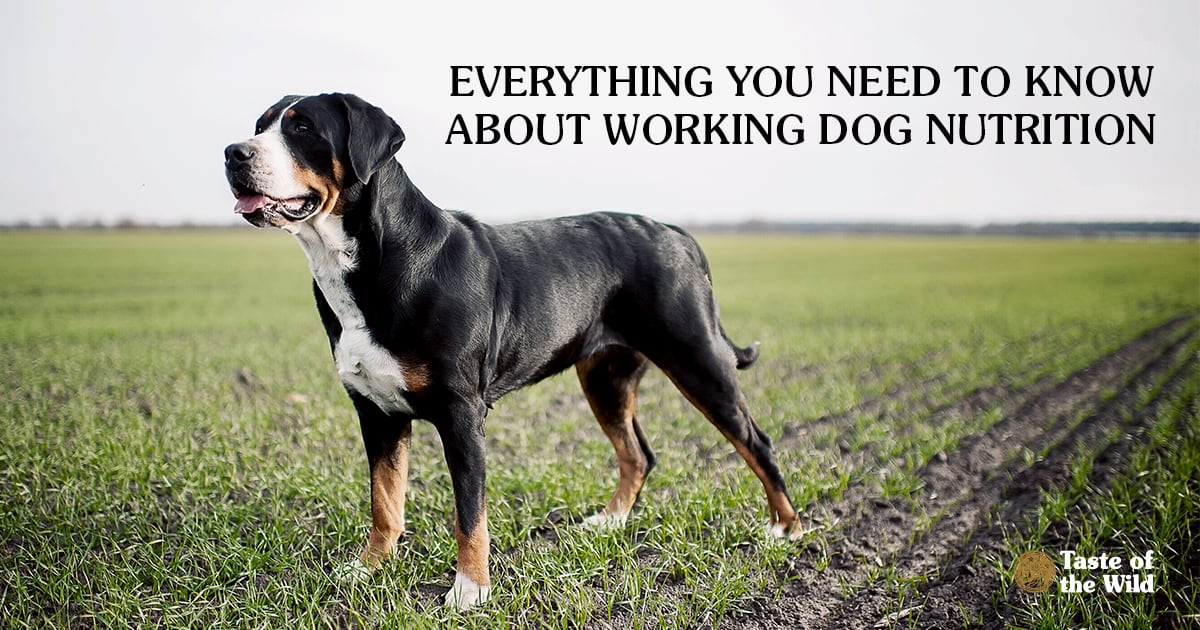
If you’ve ever worked a long, hard day, you know that what you eat can have a direct effect on how you feel and how much energy you have. Food also has this effect on your animals. Working dogs have unique nutritional needs that must be met in order for them to perform at their best.
WHAT CLASSIFIES A WORKING DOG?
Working dogs have been our loyal companions as far back as the 1600s. Typically, they’re larger breeds that are specifically bred to perform tasks like:
- Law enforcement
- Farming and herding
- Hunting
- Sledding
- Agility competitions
- Racing
- Service
- Show
While these dogs come in all shapes and sizes, the most common working dogs are known for their large, strong bodies. Working dog breeds include:
- Akita
- Alaskan malamute
- Boxer
- Bullmastiff
- Doberman pinscher
- Giant schnauzer
- Great Dane
- Mastiff
- Newfoundland
- Portuguese water dog
- Rottweiler
- Saint Bernard
- Siberian husky
- Swiss mountain dog
Other breeds may love being working dogs, as well. For example, Welsh corgis are almost never considered working dogs, but they can thrive when given the task of herding chickens and other barnyard fowl.
IS MY WORKING DOG GETTING ALL THE NUTRIENTS IT NEEDS?
Just like physical laborers, working dogs get a workout every day. As a result of their active lifestyle, they need more calories to operate at peak performance. Depending on the workload, working dogs need 1.5 to 2.5 times the amount of food as a relatively sedentary dog. Oh, and if the dogs are working in extreme temperatures, the amount of food needed increases even more.
A great source of these calories is additional fat. Fat is a long-burning nutritional source that keeps your dog moving all day long. Even non-working dogs and inactive dogs can benefit from a diet high in fats.
WHAT TO LOOK FOR IN YOUR DOG’S FOOD
When it comes to your dog’s food, there are some key things to keep in mind. Dog food must contain specific levels of proteins, carbohydrates, fats, minerals, vitamins and water.
Quality pet foods have a real animal protein as the first ingredient — such as boar, venison, turkey, whitefish or another meat, poultry or fish. All Taste of the Wild recipes have animal protein as the first ingredient. Taste of the Wild Pine Forest Canine Recipe with Venison & Legumes is a tasty choice for your working dog.
With the correct combination of these ingredients, your working dog can lead a healthy, happy life. Consult with your veterinarian about the appropriate amount to feed your working dog.
WHAT TO AVOID
Overfeeding
This includes treats and table scraps. While it may be tempting to give your dog frequent treats or rewards, it can cause an imbalance in their diet. Like human treats, dog treats are tasty because they are high in fat or salt, meaning their calories can do harm to your dog’s daily food intake.
Feeding immediately before or after strenuous activity
Feeding your dog directly before or after any strenuous activity can cause digestive problems such as diarrhea or discomfort. Typically, active dogs should be fed an hour or more after their strenuous activity.
Sudden changes in food
Sudden or drastic food changes can affect any dog, causing gastrointestinal problems. To avoid this issue, make any changes to your dog’s diet over the span of two to four weeks. This will allow your dog adequate time to adjust to any changes and ensure a healthy digestive system.
READY TO TRY TASTE OF THE WILD FOR YOUR WORKING DOG?
To find a Taste of the Wild recipe for your dog, visit our formula finder.
The information in this blog has been developed with our veterinarian and is designed to help educate pet parents. If you have questions or concerns about your pet's health or nutrition, please talk with your veterinarian.
